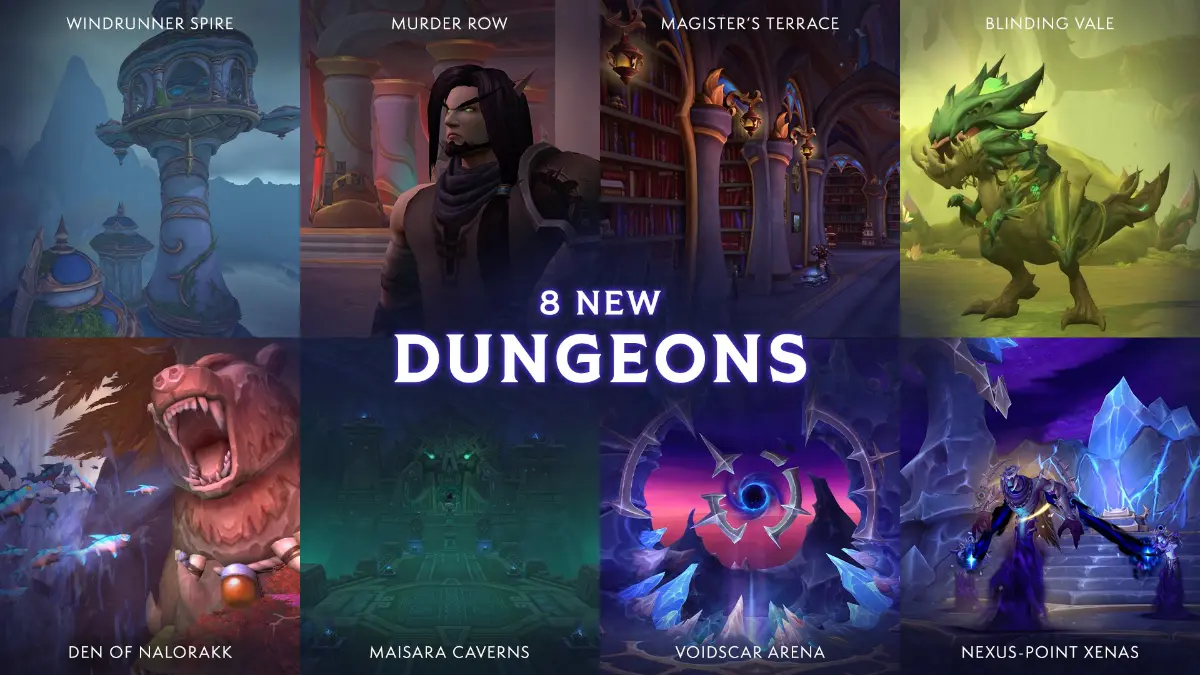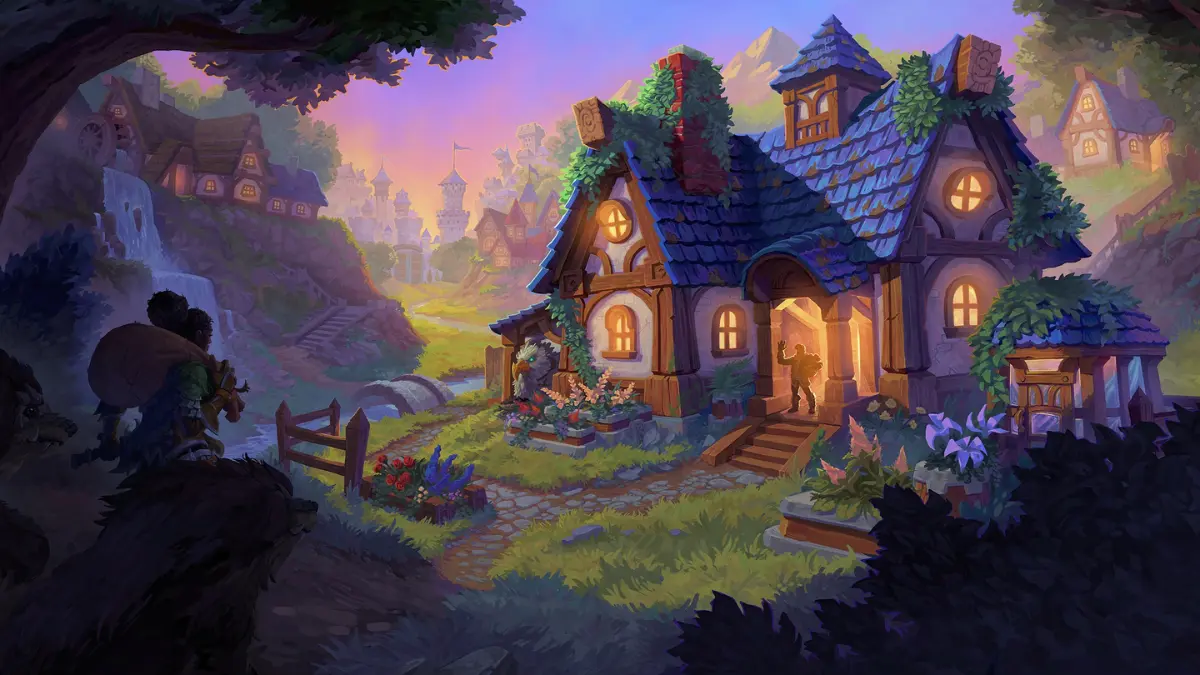During Gamescom 2025, Blizzard made an announcement that shook the entire World of Warcraft playerbase. Over 20 years after the initial release of World of Warcraft in 2004, players can finally have a place to call home on Azeroth, the main planet of Blizzard’s popular MMORPG.
Your own customizable home in Azeroth
Player housing in World of Warcraft is a long-awaited feature that gives characters a place to call their own. Depending on their faction, Horde or Alliance, players can settle in either Alliance Founder’s Point, with houses similar to the ones of Stormwind, or Horde Razorwind Shores, which look like Orgrimmar.
While every player has their own house, they won’t be isolated. Each home is part of a neighborhood, shared either with guild members or random players from the same faction. Each neighborhood contains around 50 houses, and players can choose where they want to build their home. They can settle down in lots ranging from isolated retreats to tightly clustered cul-de-sacs for greater proximity to their neighbors.
Each house comes with a yard for exterior decor, and owners can furnish their home with decorations earned through quests, raids, professions, and crafting. Once a house is purchased, it becomes shared across that player’s entire warband, allowing all their characters to access the same home and decoration collection.
Players who pre-ordered World of Warcraft’s upcoming expansion, Midnight, will get early access to the housing system on December 2, 2025. Those who didn’t pre-order the expansion will have to wait until the full release of Midnight, set to launch in 2026.
Two decades of player demands
Housing has been one of the most requested features from the community for almost two decades. Other MMOs like Final Fantasy 14, Elder Scrolls Online, and Star Wars: The Old Republic have been letting players have their own place for years now.
With the release of Warlords of Draenor back in 2014, many WoW players thought they were finally getting a version of housing. Blizzard announced the introduction of garrisons, giving everyone their own instanced plot of land, complete with buildings to place and upgrade.
But garrisons ended up being a disappointment for players who hoped for housing. Instead of granting them a home to customize, it was just a base of operation filled with buildings and NPCs. While useful, it remained far from a full-fledged housing system, leaving players still longing for a place to call home.
Over a decade after garrisons, WoW players will finally gain full access to housing with the release of Midnight in 2026. With this expansion, Blizzard will deliver a long-awaited feature, one that not only catches up with what other MMOs have been offering, but that aspires to do even better.
Home sweet home
On top of owning a piece of Azeroth, the main purpose of WoW’s housing is to let players customize their home. Blizzard announced two furnishing modes: a simple grid-based “Basic” mode and an unrestricted “Advanced” mode.
Basic mode snaps decorations to a predefined grid, like in Animal Crossing or similar games. Advanced mode, as its name suggests, is aimed at those who want full creative freedom. While objects automatically align and snap to nearby elements in Basic mode, players can rotate and freely place items off-grid in Advanced mode.
Lead UX designer Laura Sardinha notes that about “80% of players” will likely prefer Basic mode, as it provides an easier and faster way to furnish their homes.
Neighborhoods build on WoW’s social core
World of Warcraft has always been about community. From the early days of Alliance vs Horde rivalry, to the importance of joining a guild and teaming up with other players to defeat bosses in dungeons or raids, social play has always been central to WoW’s identity.
Over the last few expansions, WoW has made it easier for players to connect with each other. Since 2022, Alliance and Horde players have been able to group together, expanding opportunities for co-op regardless of faction. Housing builds on that foundation by introducing neighborhoods, small clusters of players for those wanting to get their home in Azeroth.
Each neighborhood is a persistent mini-community. Public Neighborhoods are run by the game and open to all, with new instances spawning as needed, so no one is locked out. Players choosing public housing plots will live side-by-side with strangers and friends alike.
Private neighborhoods offer more control. Guilds or groups of friends can claim a neighborhood to live “together, progress, and customize together,” according to Blizzard. A guild neighborhood supports a home for every guild member, no matter how large the guild grows, even if it exceeds 50 houses.
Neighborhood members collaborate on “Endeavors,” monthly activities that offer tasks with rewards for the entire neighborhood. Overall, player housing in WoW is a way for players to further customize their time in Azeroth and finally feel like they belong somewhere, while giving them a new weekly challenge.
Why WoW didn’t have housing sooner
Given how obvious a feature housing seems in hindsight, why did it take Blizzard 20+ years to implement? According to the developers, the answer boils down to technical challenge and scope. As design lead Toby Ragaini puts it, Blizzard “couldn’t just sort of check off a box and do the minimum” for housing.
In practice, this meant housing’s foundations had to be laid over multiple expansions, with the progressive release of various key features. Game Director Ion Hazzikostas explains that building housing “was such a significant undertaking that it wouldn’t fit in a typical expansion cycle.”
According to Hazzikostas, WoW’s housing zones are vast and persistent, rather than simple instanced maps like dungeons or garrisons. Blizzard required specific technological frameworks to support housing, and introduced some key components in previous WoW expansions.
For instance, WoW’s housing required the kind of modularity seen in Torghast, as well as the seamless instancing tech used for Delves, two major features respectively introduced in 2020’s Shadowlands and 2022’s Dragonflight.
Delivering a housing system at the scale WoW players expect required years of underlying work in the engine and game servers. With this extra lead time, Blizzard assured players they would get a robust and polished system, rather than a minimal garrison-style instance.
Blizzard can’t afford to mess this up
Since players have been waiting for over two decades for their own house in World of Warcraft, expectations are through the roof. Moreover, comparison is inevitable, as other MMOs already have it.
Design lead Toby Ragaini acknowledged that Blizzard “knew the anticipation was there”. Ragaini also stated that “we get one shot at this to impress people,” and that’s probably true. If Blizzard drops the ball on housing, this could backfire for World of Warcraft.
WoW’s popularity has seen highs and lows, and new expansions always bring back players curious to see what Blizzard has in store for its MMO. As housing has been requested for many years now, players who quit WoW might come back to try this new feature. The challenge is therefore to not disappoint them, so they stick around a little longer–and pay their monthly subscription for as long as possible.
If housing is buggy, limited, or clunky, it would be a bitter disappointment after years of waiting, and could seriously backfire. WoW players rarely refrain from expressing their disappointment on official forums and social media.
Housing is key to WoW’s future
Player housing is a potential game-changer for WoW’s longevity. The game has always struggled with keeping players busy, especially later in expansions, once they’ve fully geared with little left to grind. Servers progressively empty, before the next patch kicks in and players come back once more, before leaving again, repeating a never-ending cycle.
Housing could keep players around longer than usual, giving them something to do besides raids, dungeons, or PvP battles. Sure, customizing a home may be done quickly, but for those invested in housing, they may need to farm specific decor elements and make sure to log in weekly to contribute to their neighborhood’s Endeavours.
Moreover, there’s a key feature in housing that could be a real game-changer: the import/export system for blueprints. Players who enjoy interior design will be able to share their creations with others, just like in The Sims 4. Housing becomes an open canvas for user-generated content within WoW, encouraging players to create and share their designs.
While that may not seem like much, it still keeps players busy for an extra few hours each week. That, combined with activities like Delves, the Great Vault to fill, guild socializing, or the upcoming Prey system, might give players a reason to stay on Azeroth a little longer than they used to. Ultimately, these activities help WoW keep players busy–and, therefore, keep paying their monthly subscription.
WoW adapts to its aging playerbase
For years, the WoW community has been split into two different groups: those who enjoy the hardest challenges, whether PvE or PvP, and those who would rather chill and unwind when they play. Over the years, WoW implemented various changes that made the game more accessible to casual players, letting them access high-end gear even without raiding at the highest level, thanks to features like the weekly Great Vault and catch-up mechanisms, among others.
WoW is adapting to its playerbase. The game launched two decades ago, and part of its playerbase has grown older while roaming across Azeroth. Having less free time doesn’t mean these players shouldn’t be allowed to enjoy a game they care about for decades.
Moreover, just because some players enjoy casual play doesn’t mean it’s a threat to higher-level challenges. WoW continues to add features for those who’d just like to chill, like housing, but don’t forget about high-end PvE and PvP. The release of Midnight, for instance, will come with four new raids and an additional 40v40 battleground, so every player should find something to do, no matter their favorite activity on Azeroth.
Midnight is the expansion that could save WoW
Housing doesn’t come alone: it’s part of the larger Midnight expansion, the second chapter of the World Soul Saga. Blizzard unveiled Midnight at Gamescom 2025, promising a new chapter in WoW’s story as well as a variety of new content, ranging from housing to four new zones to explore, an additional allied race, as well as three new raids and eight dungeons.
Combat-wise, Midnight adds the Devourer specialization for Demon Hunters, giving DHs ranged Void abilities like a summonable Void Scythe. It also brings the Prey system: players can hunt powerful enemies at Normal, Hard, or Nightmare difficulty for big rewards, giving them a new PvE challenge to complete either solo or with others. For those who prefer PvP, Midnight will introduce a new 40v40 battleground named Slayer’s Rise.

All these features and new additions add to the hype surrounding the release of Midnight, scheduled to launch in 2026. This upcoming expansion is the second part of the World Soul saga, a three-part story that began with the release of 2024’s The War Within and will end with The Last Titan, which should release around 2028.
The millennial dream of owning a home
After two decades of wandering Azeroth, World of Warcraft’s heroes will finally get a place to call their own. Expectations are high, and Blizzard knows it. If done right, housing could bring players together and give them new reasons to log in each week.
In the bigger picture, WoW’s upcoming Midnight expansion comes stacked with content for both casual and hardcore players, from Prey contracts to new raids and player housing. As Midnight is the second chapter in the World Soul Saga, chances are Blizzard still has new features and stories in stock for the years to come.
Only time will tell if Blizzard can deliver on its promise. For now, Azeroth’s veterans have reason to smile, as they’re about to own a piece of the world they’ve defended for so long.

